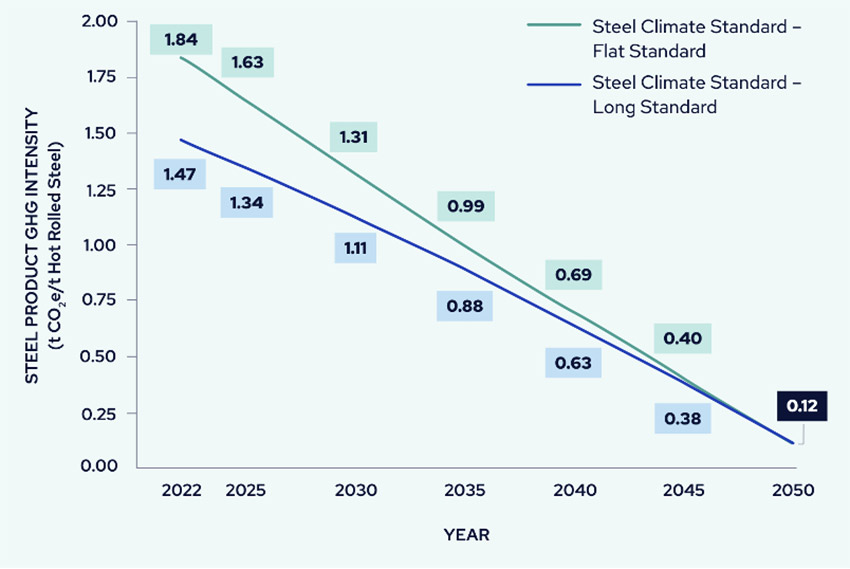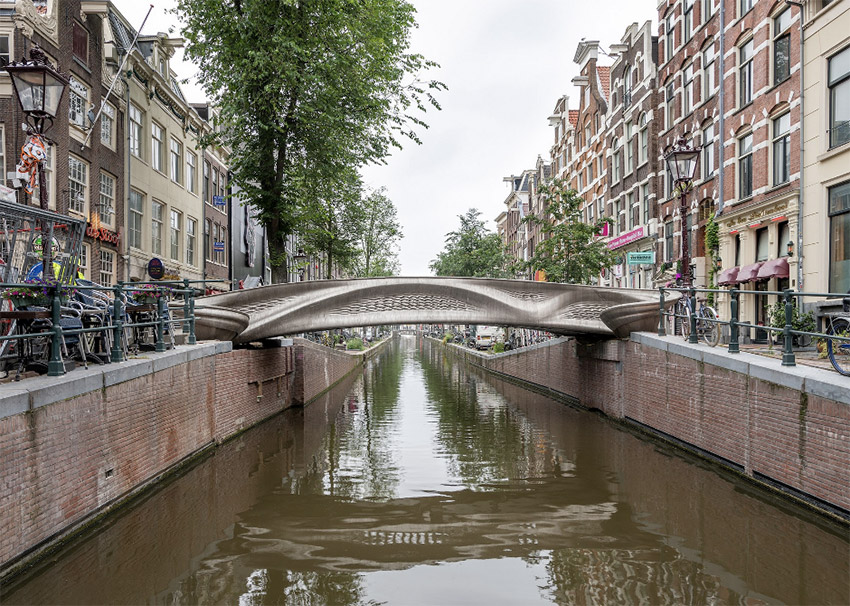Structural Steel for Low-Carbon-Emission Lightweight Frames
“The U.S. government is doing all it can to incentivize hydrogen-based steelmaking and to get people more interested in it,” Bell observes. “The Department of Energy recently identified several areas that will start research on what are called hydrogen hubs. One of the reasons hydrogen-based steelmaking has not taken hold in the U.S. is hydrogen is a very volatile substance; you have to be very careful when you store it, when you distribute it, when you ship it. And until you have a network of these hydrogen hubs existing where you can safely store it; until you have the pipelines needed to safely transport it; and until you have the trucks and other vehicles to get it from point A to point B, it’s going to be a very incremental approach. This is not something that’s going to happen in the next two or three years; it might be a decade before there’s any meaningful inroads made into hydrogen-based steelmaking here in the U.S.” The Regional Clean Hydrogen Hubs are components of Energy Secretary Jennifer Granholm’s mission to incentivize the long-range transition from fossil-fuel dependent BAU to a hydrogen-based economy, Bell adds; while recognizing the importance of that effort, he sees EAFs as a proven and readily available form of green infrastructure.
Steelmakers’ movement toward renewable energy is not as swift or thorough as many would prefer, for the all-too-familiar reasons of scale, storage, and consistency. Hill notes that in the case of Nucor, “we’re 40 percent renewable today, because the grids that we’re on are there, given where they are today in the different parts of the country.” When the firm’s new sheet steel mill opens in another roughly two years, requiring hundreds of megawatts of power at peak, he says, “when we throw the switch for that melt shop, you’ve got to have instant power. It’s got to be firm baseload energy. Solar and wind do not provide that for us in the future.” The firm is exploring nuclear fission and fusion as additional carbon-free sources, Hill says, including “small modular reactor technology on the fission side, similar to what the U.S. Navy has used for decades in the nuclear subs.” In September 2023, Nucor and Washington-based fusion-power firm Helion Energy announced an agreement to develop a 500-megawatt fusion plant directly powering a Nucor steelmaking facility, with an operation target of 2030. “If we want clean 24/7 carbon-free energy, you have to look at nuclear, because that’s the only thing from a firm baseload standpoint,” Hill says. Agreements with a wind farm in Texas and a solar project in Kentucky also demonstrate that Nucor continues to expand support for those renewable forms while looking to nuclear as a reliable source for the scale of energy its facilities need at present.
Along with energy-supply variables, the availability of scrap is an essential factor determining an EAF’s operations and emissions effects. Dennis Pilarczyk, manager of building solutions at Nucor, says, “Right now, there’s a concern that if everybody flipped from BOF to EAF tomorrow, there wouldn’t be a scrap supply to support it.” At least in the U.S., he believes, a shortage scenario is improbable and should not be a pretext for complacency about BAU. Given the extent of both construction and production of automobiles and other metallic goods within recent decades, with more buildings and products now coming offline, the U.S. is a net exporter of scrap, Pilarczyk says. A recent report prepared for the SMA, analyzing changing product lifespans and their effects on the scrap supply as well as a coming global surge in scrap as China’s steel sector has grown, supports the proposition that ample scrap is available, and will remain so, to support the continued expansion of EAF facilities (Brady and Eggert).
Other commentators, particularly focusing on supply chains outside the U.S., are less willing to dismiss concerns over the scrap supply. “We are still building a lot of infrastructure, and we are building at a quicker rate than we are generating scrap material,” says Leroy Gardner, PhD, FREng, professor of structural engineering at Imperial College, London. “As things stand, I think there's probably a global overdemand for scrap steel, and that is a limitation; we will still need for some period to be producing new steel from raw materials [by the] blast-furnace route. And you could imagine at some point there will be something like an equilibrium of scrap and demand, but we're certainly not going to be there for a number of decades.”
Houska views this condition as an impetus for architects, fabricators, and product designers to consider an underappreciated aspect of cradle-to-cradle circularity: “the design of products so that they can be separated.” More attention to end-of-life disassembly would improve the flow of materials into the scrap supply, she says, and reduce the problem of removing impurities at the melting stage. “If you are going to combine metals, for example, wall panels often might have stainless steel on the outside and aluminum on the inside of the sandwich panel, and if you can’t effectively separate the metals, then that might not be recyclable. So keeping it all steel would make a huge difference.”
DEFUSING THE GREENWASHING CRITIQUE THROUGH STANDARDS
Efforts to decarbonize the economy must come to terms with the fact that steel inevitably contains carbon. “You’ll never decarbonize it,” says Bell, “but you can lower the carbon emissions of the steel you produce” with EAFs, scrap recycling, and cleaner energy sources; decarbonization in construction or any other field is a matter of degree and measurement. These efforts’ vulnerability to accusations of greenwashing, a nearly inevitable reaction as terms like “green steel,” “clean steel,” and “sustainable steel” circulate, are reducible when standards are developed by recognized authorities and applied uniformly throughout the field.
Sustainability standards vary, Bell acknowledges: “there’s over 50 of them out there. But probably the top one that defines it in a way that's clear and easy to understand is the Global Steel Climate Council (GSCC) standard,” which the SMA supports. It is “based on a very simple concept. Steel is going to be green or not based on the absolute value of its CO2 emissions; you don’t need anything else involved in that calculation. Social responsibility is great. Planting trees is great. All of that is great. But at the end of the day, what this is about is carbon emissions, and we have a standard that’s based on a single line of attainment. If you’re above that line, you're high-emitting. If you're on that line, you’re okay; if you’re below that line, you’re even better, but you still are incentivized to continually improve and lower your emissions so that it’s aligned with the 1.5-degree scenario outlined by the Paris Climate Agreement.”
The international nonprofit GSCC formed in 2022 and issued its standard in 2023, rejecting calls for a “ferrous scrap sliding scale” that would allow extractive steelmakers a “green” label based on emissions up to ninefold higher than that applied to recycled products (Global Steel Climate Council). The GSCC’s standard addresses Scopes 1-3 GHG emissions from scrap collecting, processing, and hot rolling; regularly tightens its requirements along a “decarbonization glidepath” toward net zero emissions by 2050 (see Figure 4); requires independent third-party verification of calculations and reduction targets; offers product certification as an option, lasting three years and renewable after that period with verification held to the current standard; and excludes carbon offsets or insets (compensatory activities outside or inside a company’s value chain, e.g., purchasing external carbon offsets or planting trees as an onsite carbon sink, respectively), a common greenwashing mechanism. “The greenwashing is really being done by those that are trying to promote the old, dirty way of making steel,” Bell contends, “trying to say that steel made with a blast furnace can have the potential to be just as clean as steel made in an EAF.”

Graph courtesy of Global Steel Climate Council
Figure 4. Steel Climate Standard flat and long steel product intensities. Source: Global Steel Climate Council, The Steel Climate Standard, Fig. 3-1.
Houska agrees that the industry needs rigorous and accepted benchmarks, “similar to the standards that were established by the wood industry to certify sustainable forests and forest management as opposed to clear cutting.” Her experience with standards development includes chairing the subcommittee on E60.80 General Sustainability standards for ASTM (previously the American Society for Testing and Materials) and service on several AISC committees. Standards developed by professional organizations for carbon steel, stainless steel, alloy steels, and other metals, she notes (citing the Copper Mark, the Nickel Institute, the International Molybdenum Association, the Chromium Development Association, and the International Zinc Association) are gradually overcoming gaps in data on life-cycle assessment of products using the materials and submitting standards to the ASTM and International Organization for Standardization, which carry more authority than intra-industry organizations do. “There is a huge effort on the part of the International Council on Mining and Metals to develop standards. There has already been an effort on the part of specific alloy elements to create standards and certification systems that are third-party-verified, [ensuring] that mines are very responsible.... There are mining operations, I'm fairly certain, where their extraction facilities could get LEED Platinum. They're using solar power; all the water that is used is carefully processed.” Even in parts of the world where provisions are less stringent, she says, “there are mines that are really taking significant actions to make sure that what they're doing is sustainable and protecting the miners' lives. Mining isn't what it was 100 years ago.”
Puchtel points out that governmental decarbonization standards, initiated in 2008 by California's CalGREEN (Green Building Standards Code, Part 11 of the state's building code) and followed by similar programs in other states, are likely to appear soon at the federal level as an Environmental Protection Agency initiative. “Part of what the EPA is doing right now,” he says, “with money they received from the Inflation Reduction Act, is creating a labeling program similar to what consumers are familiar with, like WaterSense or EnergyStar. So EPA plans to create a label program that will rate construction materials based on their embodied carbon.” Steel is one of four materials (along with cement/concrete, glass, and asphalt) identified in an EPA Interim Determination as priorities for Environmental Product Determination assistance and the new labeling program (EPA 2023). Specifiers and clients alike, provided the program is not derailed by politics, will benefit from clearer communications about the embodied-carbon effects of the available materials. Puchtel's colleague Carter also points out that code centralization in the form of the International Building Code and its incorporation of AISC standards by reference, along with the economic advantages of sustainable choices (already evident from the U.S. shift to EAFs) “makes it somewhat idiot-proof, regardless of how politics goes.”
Rarely, but sometimes significantly, a technology will be too new for existing standards to offer meaningful guidance (see Case Study below: “MX3D's Amsterdam Bridge: Pioneer Project or One-Off?”).
CASE STUDY: MX3D'S AMSTERDAM BRIDGE: PIONEER PROJECT OR ONE-OFF?
One innovation in the use of steel lacks impressive emissions metrics─for now─but points the way toward a promising disruption in design and material delivery. A new method of producing steel directly at the site needed, printing three-dimensional forms from wire feedstock in layers with a digitally guided robotic instrument, offers both the possibility of extraordinary efficiencies and the challenge of scaling up the process to the point where those efficiencies might benefit a wide range of structures.

Photo © Thea van den Heuvel; courtesy of Arup
Figure 5. MX3D's bridge in place across the Oudezijds Achterburgwal, Amsterdam.









